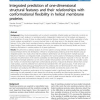Free Online Productivity Tools
i2Speak
i2Symbol
i2OCR
iTex2Img
iWeb2Print
iWeb2Shot
i2Type
iPdf2Split
iPdf2Merge
i2Bopomofo
i2Arabic
i2Style
i2Image
i2PDF
iLatex2Rtf
Sci2ools
BMCBI
2010
2010
Integrated prediction of one-dimensional structural features and their relationships with conformational flexibility in helical
Background: Many structural properties such as solvent accessibility, dihedral angles and helix-helix contacts can be assigned to each residue in a membrane protein. Independent studies exist on the analysis and sequencebased prediction of some of these so-called one-dimensional features. However, there is little explanation of why certain residues are predicted in a wrong structural class or with large errors in the absolute values of these features. On the other hand, membrane proteins undergo conformational changes to allow transport as well as ligand binding. These conformational changes often occur via residues that are inherently flexible and hence, predicting fluctuations in residue positions is of great significance. Results: We performed a statistical analysis of common patterns among selected one-dimensional equilibrium structural features (ESFs) and developed a method for simultaneously predicting all of these features using an integrated system. Our results show that the p...
| Added | 08 Dec 2010 |
| Updated | 08 Dec 2010 |
| Type | Journal |
| Year | 2010 |
| Where | BMCBI |
| Authors | Shandar Ahmad, Yumlembam Hemjit Singh, Yogesh Paudel, Takaharu Mori, Yuji Sugita, Kenji Mizuguchi |
Comments (0)

